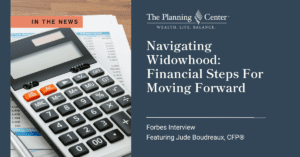On Friday, March 27th President Trump signed the Coronavirus Aid, Relief, and Economic Security (CARES) Act into law.
This legislation is being billed as the largest aid and relief act in the history of the United States, and is designed to support individuals and businesses as we all weather this Coronavirus 19 (CV19) storm.
The CARES Act provides a number of key programs for small businesses, which we’ll do our best to summarize. The provisions in this legislation are somewhat complex, so we’d suggest consulting with your planner or tax professional if you are considering utilizing these measures.
Paycheck Protection Program
- Provides support to small businesses for the purpose of retaining employees through loans that are fully guaranteed by The Small Business Administration (SBA)
- These loans will be issued by SBA approved lenders and others specifically designated by the SBA.
- The application deadline for the loans is June 30, 2020
- It’s been advised that small business owners connect with a lender, and start the process early, as even under normal circumstances the SBA process is not quick.
- The loan repayment period may vary, with a maximum duration of 10 years.
- Eligibility
- Employers with less than 500 employees, or the employee size standard under NAICS (if larger)
- Some employers with more than 500 employees, but multiple-location establishments in certain sectors (i.e. food and beverage businesses) may be eligible if they have less than 500 employees per location.
- The loans will require a good-faith certification (from the business owner(s)) that the loan is necessary due to the uncertainty of current economic conditions caused by CV19.
- This could include maintaining the cost of qualified health care expenses allocable to wages.
- The legislation gives leeway to the lender to approve loans given uncertainty of current conditions.
- The maximum allowable loan available to an employer equals the lesser of:
- $10 million
- 5X the average monthly payroll from the previous year (2019).
- Employers with less than 500 employees, or the employee size standard under NAICS (if larger)
-
-
-
- The loan calculation excludes the pro rata portion of compensation above $100,000 per year for “high earners”.
-
-
- Loan Proceeds from the Paycheck Protection program can be used to:
- Cover payroll costs
- Pay group health insurance premiums or other healthcare costs
- Maintain salaries/commissions
- Pay rent or mortgage interest (excluding amounts pre-paid)
- Maintain other business interests incurred prior to Feb 15, 2020
- A portion of these loans may be forgivable under certain circumstances. Forgivable portion of loan equals 100% of amount spent on the following during the 8-week period following the issuance of the loan (not completely equivalent to the “proceeds used for” list above)
- The forgivable portion can equal up to 100% of the amount spent on the following during the 8-week period from the issuance of the loan:
-
-
- Payroll costs, excluding prorated amounts for comp >$100k
- Rent pursuant to a lease in force before Feb 15, 2020 (mortgage expenses NOT forgivable)
- Electricity, gas, water, transportation, telephone or internet expenses for services that began before Feb 15, 2020
- Group health insurance premiums and other healthcare costs
-
- Loans, or portions of a loan, are only forgivable if:
- The employer maintains the same # of employees from Feb 15, 2020 through June 30, 2020 as either
- During the same period in 2019
- Jan 1, 2020 until Feb 15, 2020
- In other words, employers can’t make staff reductions related to CV19 events while still allowing for “seasonal” employees to be taken into account.
- No employees with compensation under $100k have reductions of more than 25% compared to the most recent quarter.
- If those already laid off or furloughed (prior to knowledge of this relief) are hired back quickly there is a mechanism to qualify for this forgiveness.
- The employer maintains the same # of employees from Feb 15, 2020 through June 30, 2020 as either
- Other benefits related to the Paycheck Protection Program include:
- Any amount of debt discharged/forgiven based on the criteria above is non-taxable income.
- The maximum interest rate on these loans is 4%
- Initial payments on all borrowed amounts through this program can be deferred for 6-12 months
- *The specifics have yet to be determined, with the written law suggesting that the SBA will provide rules to give guidance on when payments begin, not to be shorter than 6 months, not to be longer than 12 months.
In addition to the Paycheck Protection provisions, the CARES Act establishes an Employee Retention Credit
- This provision is a new credit against payroll taxes in the amount of 50% of wages paid to each employee, up to maximum of $10k of wages/person.
- For the purposes of this credit, eligible wages are:
- For businesses up to 100 employees, all wages paid (up to $10k per employee).
- For employers with greater than 100 employees, only wages paid to individuals not providing services due to government shutdown or required revenue decline are eligible.
- Eligible compensation includes the cost of qualified health care expenses.
- For a business to qualify for the Employee Retention Credit, they must either:
- Have business operations that are partially or fully suspended due to government-required suspension; or
- Have a quarter with a loss of 50% of revenue (not profit) when compared to the same quarter in 2019.
- Employers will qualify to receive this credit until:
- The end of calendar year 2020, or
- Once suspended operations resume, the business’s revenue is back above 80% of same calendar quarter from 2019.
Even if an employer does not qualify for the Employee Retention Credit, there is some relief in the form of a Deferral of Payroll Taxes.
- All employers will be permitted to defer 2020 payroll taxes to help ease pressure on cash flow.
- 50% of all deferred taxes will be due on 12/31/2021
- The remaining 50% of deferred taxes will be due on 12/31/2022
- These “paybacks” are in addition to “normal” payroll taxes that would be due in 2021 and 2022.
- The Deferral of Payroll Taxes provision also applies to self-employed individuals. (only “employer” portion)
- For the self-employed, only the “employer” portion of the self-employment tax may be deferred.
- In essence, this gives self-employed individuals an opportunity to defer 50% of SE taxes through 2021 and 2022.
- 25% of total 2020 SE tax is due by 12/31/2021, the other 25% by 12/31/2022.
Finally, the CARES Act provisions allow for the Net Operating Loss (NOL) Rules to be loosened for 2020.
- Prior to the TCJA of 2018, NOLs could only be carried back 2 years, or forward up to 20
- TCJA changed the rules, beginning in 2018, to allow for indefinite carry-forward
- TCJA had eliminated the carry-back option
- CARES Act allows NOLs to be carried back up to 5 years
- This applies for 2018, 2019 or 2020 NOLs
- The provision accelerates a tax refund for current/immediate use
- In addition to the carry-back provision, NOLs will now be able to offset 100% of taxable income (up from 80% under the prior rules).
- TCJA changed the rules, beginning in 2018, to allow for indefinite carry-forward
Given the complexity of many of these options, we’d suggest consulting with your TPC planning team and your tax professional.
Please contact us with any questions you may have!
The Planning Center is a fee-only financial planning and wealth management firm.
Email us at: clientservices@theplanningcenter.com.







